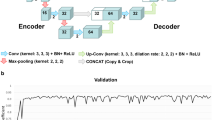Abstract
The objective of this study was to establish an anatomical atlas and a three-dimensional model of the fetal heart. To do this, we created a 60-μm cross-sectional image database of the heart of a Chinese male fetus. A 31-week stillborn fetus with no congenital defects was used as the model. All thoracic organs were removed from the thoracic cavity after formalin fixation and then frozen at −25°C for 2 h. Frozen serial sections, 60-μm thick, were prepared and macroshot with a digital camera to obtain image data. Eight hundred seventy-one cross-sectional photos of the fetal heart were made at a resolution of 3888 × 2592 pixels. The atrioventricular cavity, as well as other fine structures, was revealed in the images, showing a clear boundary between the peripheral tissues. This rich database showing the three-dimensional features and anatomy of the fetal heart will be useful for teaching, scientific research, and clinical applications.





Similar content being viewed by others
References
Freudenberg J, Schiemann T, Tiede U et al (2000) Simulation of cardiac excitation patterns in a three-dimensional anatomical heart atlas. Comput Biol Med 30:191–205
Guo YL, Heng PA, Zhang SX et al (2005) Thin sectional anatomy, three-dimensional reconstruction and visualization of the heart from the Chinese. Visible Human Surg Radiol Anat 27:113–118
Hoffman JI, Kaplan S (2002) The incidence of congenital heart disease. J Am Coll Cardiol 39:1890–1900
Hosono M, Nakano Y, Urayama S et al (1995) Three-dimensional display of cardiac structures using reconstructed magnetic resonance imaging. J Digit Imaging 8:105–115
Spitzer V, Ackerman MJ, Scherzinger AL et al (1996) The visible human male: a technical report. J Am Med Inform Assoc 3:118–130
Trobec R, Slivnik B, Gersak B et al (1998) Computer simulation and spatial modelling in heart surgery. Comput Biol Med 28:393–403
Vahl CF, Meinzer CF, Hagl S (1991) Three-dimensional presentation of cardiac morphology. Thorac Cardiovasc Surg 39(Suppl):198–204
Yuan L, Tang L, Huang W et al (2003) Construction of dataset for virtual Chinese male no. 1. J First Mil Med Univ 23:520–523
Yuan X, Wang HS, Yan SJ et al (2006) Results of surveillance on CHD in 10, 665 children and analysis of its environmental risk factors. Mater Child Health Care China 21:781–783
Author information
Authors and Affiliations
Corresponding author
Rights and permissions
About this article
Cite this article
Pei, Q., Liang, M., Huang, X. et al. Construction of a Three-Dimensional Anatomical Database of the Human Fetal Heart. Pediatr Cardiol 31, 234–237 (2010). https://doi.org/10.1007/s00246-009-9596-x
Received:
Accepted:
Published:
Issue Date:
DOI: https://doi.org/10.1007/s00246-009-9596-x




